
95% of researchers rate our articles as excellent or good
Learn more about the work of our research integrity team to safeguard the quality of each article we publish.
Find out more
ORIGINAL RESEARCH article
Front. Cell. Infect. Microbiol. , 04 September 2024
Sec. Intestinal Microbiome
Volume 14 - 2024 | https://doi.org/10.3389/fcimb.2024.1414196
Background: There is a crosstalk between gut microbiota and radiotherapy. The aim of this study is to use bibliometric analysis to explore the research status and development trends of research on gut microbiota and radiotherapy.
Methods: A literature search regarding publications on gut microbiota and radiotherapy from 2004 to 2023 was retrieved. CiteSpace and VOSviewer were used to conduct the bibliometric analysis. The growth rate of publications, leading countries and institutions, preferred journals, top authors and co-cited authors, top co-cited references, keywords and citation were analyzed in this study.
Results: A total of 2821 papers were extracted. The number of papers has increased rapidly over the past decade, especially after 2017. The USA and China had the most publications and made great contributions to this field. The Chinese Academy of Sciences stood out as the institution with the highest number of publications, followed by the Chinese Academy of Medical Sciences & Peking Union Medical College. The most influential authors were Fan Saijun and Li Yuan. PLoS One had the most publications and the most total citations. Highly cited papers and high-frequency keywords illustrated the current status and trends. Furthermore, analysis of keyword with burst revealed that immunotherapy, acid, intestinal barrier, therapy, immunotherapy, fecal microbiota transplantation, etc, are at the forefront of research in this area.
Conclusion: This study provides an overview of research on gut microbiota and radiotherapy, highlighting influential contributors, impactful publications, and emerging trends. Our finding suggests avenues for further exploration to improve clinical outcomes.
In recent decades, gut microbiota, a key regulator of host metabolism and immunity, has gained attention for its role in modulating radiation effects. This complex microbial community exhibits a bidirectional interaction with radiotherapy, influencing both the treatment’s efficacy and associated radiation injury (RI) (Dong et al., 2021; Li et al., 2022; Wang et al., 2023a).
Emerging research has demonstrated that gut microbiota may enhance the radiosensitivity (Crawford and Gordon, 2005; Paulos et al., 2007; Cui et al., 2016). A preclinical study has suggested a correlation between the gut microbiota and reduced efficacy of radiotherapy in patients treated with antibiotics (Nenclares et al., 2020). Nevertheless, with limited data available, the gut microbiota has also been implicated in the modulation of resistance to radiotherapy (Yang et al., 2019; Yang et al., 2022). For example, turmeric powder has been found to protect the gut microbiota from imbalances caused by radiotherapy, which partly explains the pharmacodynamic mechanism of turmeric powder in radio sensitization, and indirectly reflects the negative correlation between intestinal microbiota imbalance and therapeutic effect (Yang et al., 2019).
In addition, gut microbiota has also been shown to be involved in RI, spanning across various organs, including the skin (Ramadan et al., 2021; Trompette et al., 2022), brain (Liu et al., 2019; Song et al., 2022), lung (Chen et al., 2021), heart (Bartolomaeus et al., 2019; Chen et al., 2021), gastrointestinal tract (Reis Ferreira et al., 2019; Wang et al., 2023c), liver (Miousse et al., 2020), and hematopoietic system (Lucas et al., 2018; Guo et al., 2020; Lee et al., 2021). Molecular mechanisms such as DNA damage, oxidative stress, and inflammation underlie these radiation effects, with the gut microbiota playing a critical role in modulating these pathways (Russo et al., 2019; Nishiyama et al., 2021; Liu et al., 2022). However, emerging evidence suggests that interventions targeting gut microbiota, such as fecal microbiota transplantation, probiotics, and prebiotics, offer promising avenues for mitigating RI (Schuijt et al., 2016; Chen et al., 2021; Zeng et al., 2023). These approaches aim to restore gut microbiota diversity, strengthen the intestinal barrier, and modulate immune responses, thereby reducing the severity of radiation-induced damage.
Bibliometric analysis has emerged as a powerful method for examining research trends and the impact of scientific publications (Noda et al., 2023; Su et al., 2023; Wang et al., 2023b). This approach involves quantitatively assessing various aspects of scholarly work, such as publication output, citation patterns, and collaboration networks. However, there is currently no article on the quantitative analysis of interactions between gut microbiota and radiotherapy. Therefore, by employing bibliometric techniques, the aim of this study include: (1) summarizing the historical features of literature on gut microbiota and radiotherapy; (2) highlighting articles that have made significant contributions to the field; (3) recognizing the active topics of the research field; and (4) revealing emerging trends for future research.
The Web of Science Core Collection (WoSCC) database is widely regarded as the optimal choice for literature analysis due to its superior accuracy in labeling literature types (Thelwall, 2008; Merigó and Yang, 2017). We retrieved all relevant articles in WoSCC, within the timeframe from January 1, 2004 to November 29, 2023. The search strategy applied was tab search (TS) = “radiotherapy” and “gut microbiota” and their synonyms. The detailed search strategy is in Supplementary Table 1. The literature selection of this study is based on the following inclusion criteria: (1) The period of the literature search was from January 1, 2004 to November 28, 2023; (2) The language type was set to only English; (3) Document types were limited to “article” and “review”. During the process of reviewing the articles, any identified articles referenced were included as well. Two researchers (SW and XG) independently performed the search and data extraction. All searches were performed on the same day (November 28, 2023) to avoid the bias caused by database updates. All available information such as title, author, institution, country, publication year, and keywords from the raw data were collected. The WoSCC was used to download all records as plain text file exported.
GraphPad Prism v8.0.2 (GraphPad Software, Boston, USA) was used to analyze and plot annual paper publication trends and ratios at the national level. CiteSpace (version 6.1.6R, advanced edition) which was developed at Leiden University’s Centre for Science and Technology Studies, and VOSviewer (version 1.6.18), which was developed by Chaomei Chen at Drexel University, Philadelphia, United States, were used for data analysis and to visualize the scientific knowledge map. CiteSpace is widely used software for academic literature analysis, capable of generating temporal network maps that highlight key paths and evolutionary trends within the literature (Chen, 2006; Chen and Leydesdorff, 2014). VOSviewer v1.6.17, developed by Waltman et al. in 2009, is a free JAVA-based software used for analyzing extensive literature data and displaying it in map format (Van Eck and Waltman, 2010; Van Eck and Waltman, 2017). To visualize research achievements in a specific field by plotting a co-citation network of papers, professor Chen created the software CiteSpace (version 6.1.6R). This software is designed to explore new concepts and evaluate existing technologies within an experimental framework. It empowers users to gain a deeper understanding of knowledge domains, research frontiers, trends, and anticipate future advancements in research. All single images are provided as supplementary files (Supplementary Data Sheets 1, 2).
Ethical approval was waived by the local ethical board because the data came from public databases, and no human or animal subjects were involved.
After screening, our study identified a total of 2821 literature articles concerning on gut microbiota and radiotherapy in the WoSCC database (Figure 1), comprising 2410 articles (85.43%) and 415 reviews (14.57%). These articles spanned the period from January 1, 2004 to November 29, 2023, contributions from 114 countries and regions, 3,395 institutions, and 14,351 authors.
Starting from 2004, there has been a gradual increase in the annual number of publications (Figure 2A). This upward trend can be divided into three phases: a slow growth period from 2004 to 2010, with fewer than 100 papers published annually, suggesting limited attention to this field. The second phase from 2010 to 2017 saw a gradual increase in publications, suggesting the growing interest in this field. After 2017, a rapid increase in publications was observed, peaking in 2022, indicating widespread attention to this field after 2017.
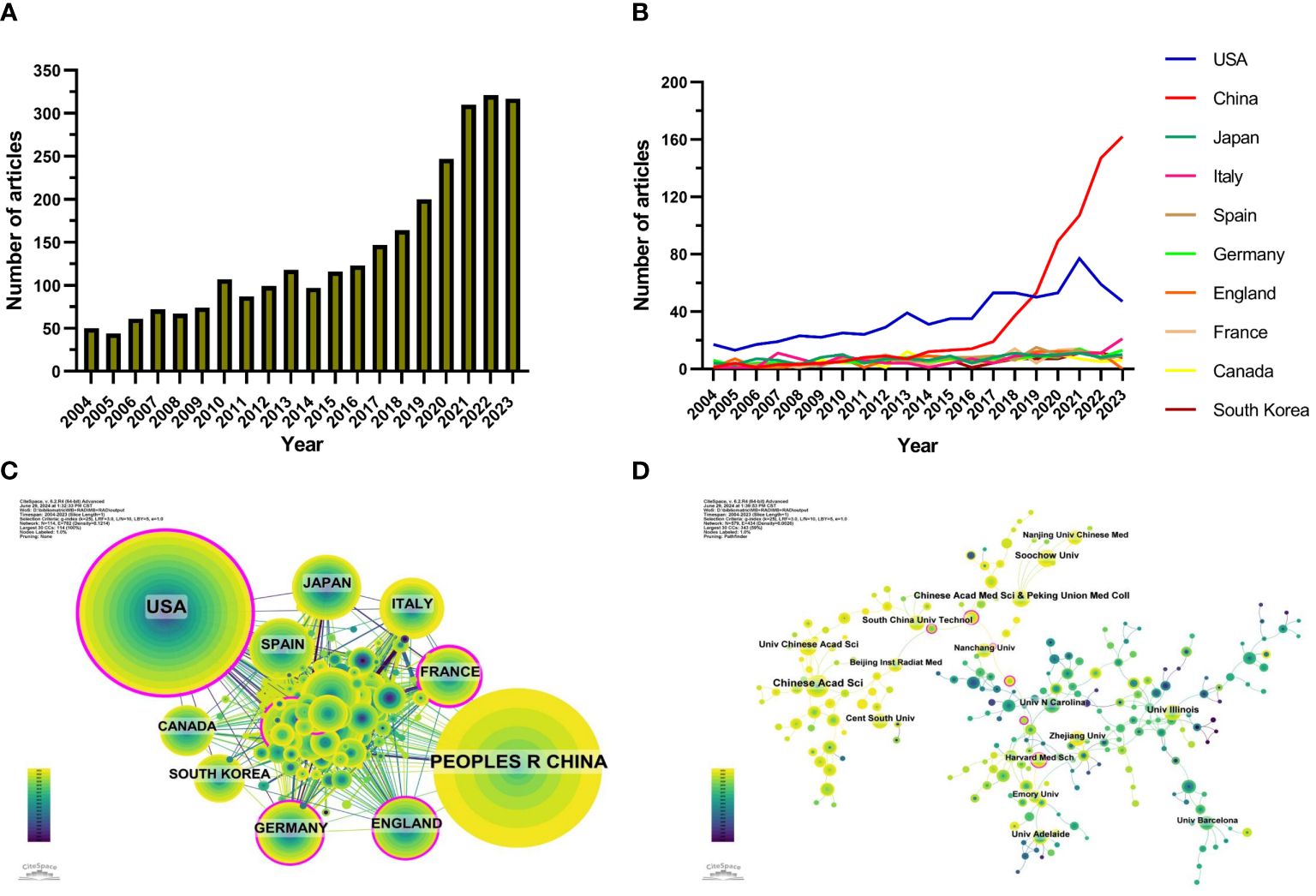
Figure 2. (A) Number of publications per year from 2004 to 2023 based on results following the strategy in Figure 1 (B) Number of publications per country from 2004 to 2023. (C) A Cooperation map of countries obtained with Cite-Space. The size of the nodes’ concentric circles represents the publication volume of each country; the larger the circle, the greater the publication volume. The colors from purple to yellow correspond to the annual time periods of publications from 2004 to 2023. The outermost purple ring indicates the extent of the node’s connections with other nodes, with a wider purple ring signifying higher centrality. (D) The cooperation network map of institutions generated by CiteSpace. Each node represents an institution and the node size is proportional to the number of publications by that institution. The connecting line between nodes indicates the cooperation relationship, and the value of link strength is also displayed between lines. The colors from purple to yellow correspond to the annual time periods of publications from 2004 to 2023.
Research on gut microbiota and radiotherapy has been conducted in 114 countries and regions. Figure 2B shows the trend in annual publication volume for the top 10 countries over the past two decades. The top five countries ranked by the quantity of articles in this field were the USA, China, Japan, Italy, and Spain (Table 1). Notably, the USA and China combined accounted for 50.30% of the total publications, substantially exceeding other countries.
In the top ten publishing countries and regions, the USA led with 30,052 citations, ranking second in citations per publication (41.62). China, with the second-highest publication volume (698), had the second-highest citation volume (11,270) but the lowest citations per publication (16.12) among the top ten countries and regions, suggesting generally lower quality of publications.
The cooperation map of countries (Figure 2C) demonstrated a close collaboration between the highest-producing countries, the USA and China, with the USA also closely collaborating with France, Germany, and the United Kingdom, while China’s collaborations were more extensive with Japan, Canada, and South Korea. The centrality of 0.47 for the USA highlights its leading position in this field.
Of the 3,395 institutions publishing articles on gut microbiota and radiotherapy, the top ten institutions included seven from China, two from the USA, and one from Australia (Table 2; Figure 2D). The Chinese Academy of Sciences stood out as the institution with the highest number of publications (36 papers, 620 citations, averaging 17.22 citations per paper), followed by the Chinese Academy of Medical Sciences & Peking Union Medical College (22 papers, 314 citations, averaging 14.27 citations per paper), and Soochow University (21 papers, 175 citations, averaging 8.33 citations per paper). These findings indicated a preference for institutions to collaborate within their own countries, highlighting the need for enhanced international collaboration to break academic barriers.
Figure 3A shows the density visualization map of productive journals, with the top ten productive journals listed in Table 3. PLoS One (80 publications, 2.13%) is the most productive journal in this field, followed by Front Microbiol (60 publications, 2.13%), Water Res (46 publications, 1.63%). Among the top ten productive journals, Water Res had the highest impact factor (IF) of 12.8, with all journals classified within Q1 or Q2 categories.
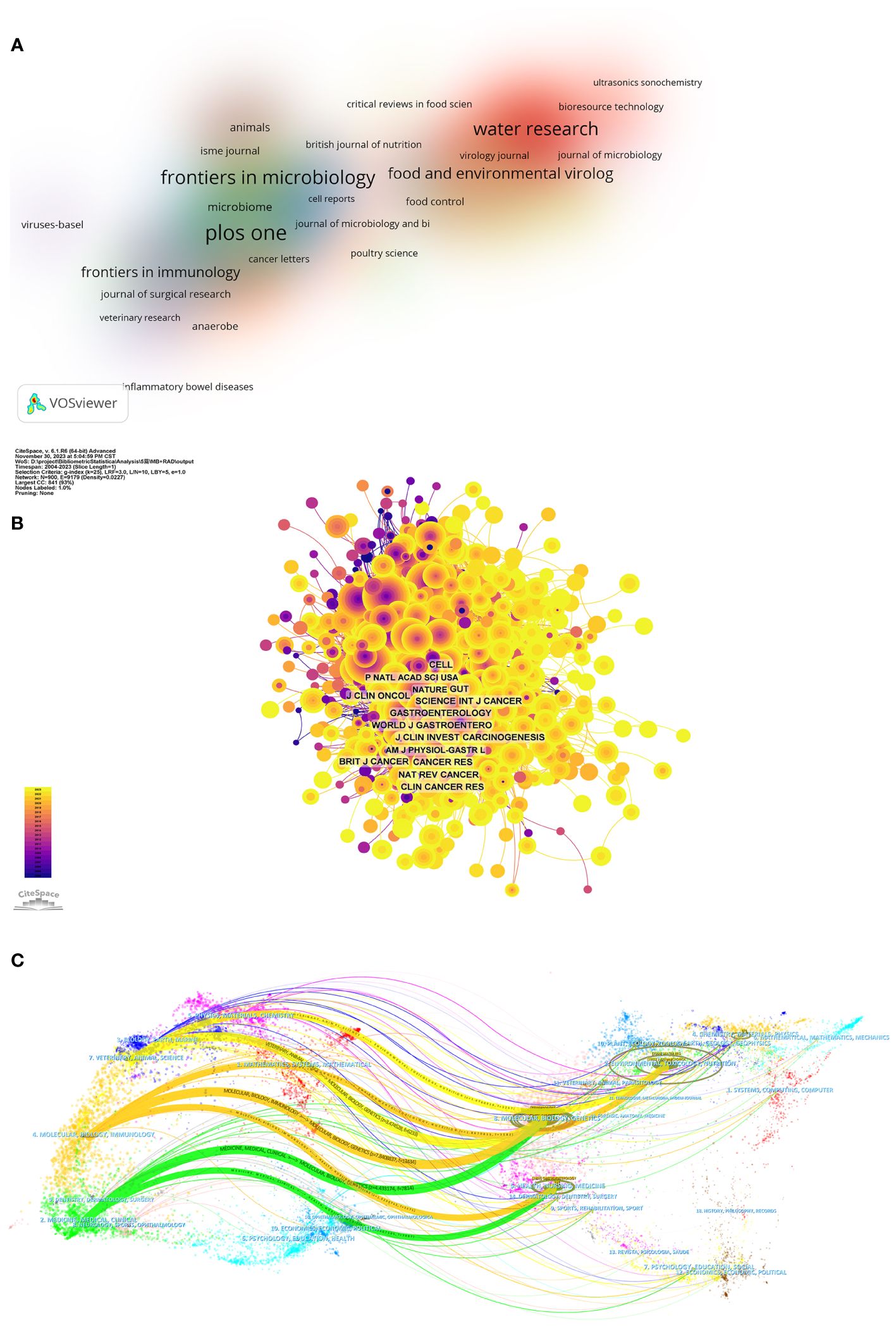
Figure 3. (A) Density visualization map of productive journals obtained with VOS Viewer. Colors represent clusters automatically calculated by VOSviewer. (B) Network map of co-cited journals obtained with Cite-Space, with the highest font size journal. The nodes represent co-cited journals. The lines between the nodes represent co-citation relationships. The larger the node area, the larger the number of co-citations. The colors from purple to yellow correspond to the annual time periods of publications from 2004 to 2023. (C) The dual-map overlay of journals obtained with Cite-Space. Each dot on the map represents a journal, with journals citing the references located on the left side and journals being cited located on the right side. The weight given to the color of a certain cluster is determined by the number of items belonging to that cluster in the neighborhood of the point, with each color indicating each cluster.
The influence of a journal is determined by the frequency of its co-citations, indicating its significant impact on the scientific community. As shown in Figure 3B and Table 4, the journal most frequently co-cited is PLoS One (1234 times), followed by Appl Environ Microb (1128 times) and P Natl Acad Sci USA (1049 times). Among the top 10 most co-cited journals, Nature stands out with 1033 citations, possessing the highest IF (64.8). All these journals with high co-citation frequencies are ranked in either the Q1 or Q2 categories.
The dual map overlay is an analytical method that shows domain-level citation concentration with their reference paths. As shown in Figure 3C, the colored path represents the citation relationship, with the citing journals on the left and the cited journals on the right. We identified seven primary citation paths. Studies published in the molecular/biology/immunology fields are mainly cited by research in molecular/biology/genetics, environmental/toxicology/nutrition, and health/nursing/medicine fields. studies from medicine/medical/clinical fields are predominantly cited by research in molecular/biology/genetics and health/nursing/medicine. Furthermore, studies published in the veterinary/animal/science field are mainly cited by research in molecular/biology/genetics and environmental/toxicology/nutrition fields.
Among authors contributing to this field, the top ten published a total of 169 papers accounting for 5.99% of all publications. Fan Saijun has the highest number of research publications (21 publications), followed by Li Yuan (20 publications) and Cui Ming (19 publications) (Table 5; Figure 4A). Further analysis reveals that six of the top ten authors were from China, three from Japan, and one from the USA. Network visualization by CiteSpace showed these authors’ collaborative relationships (Figure 4B).
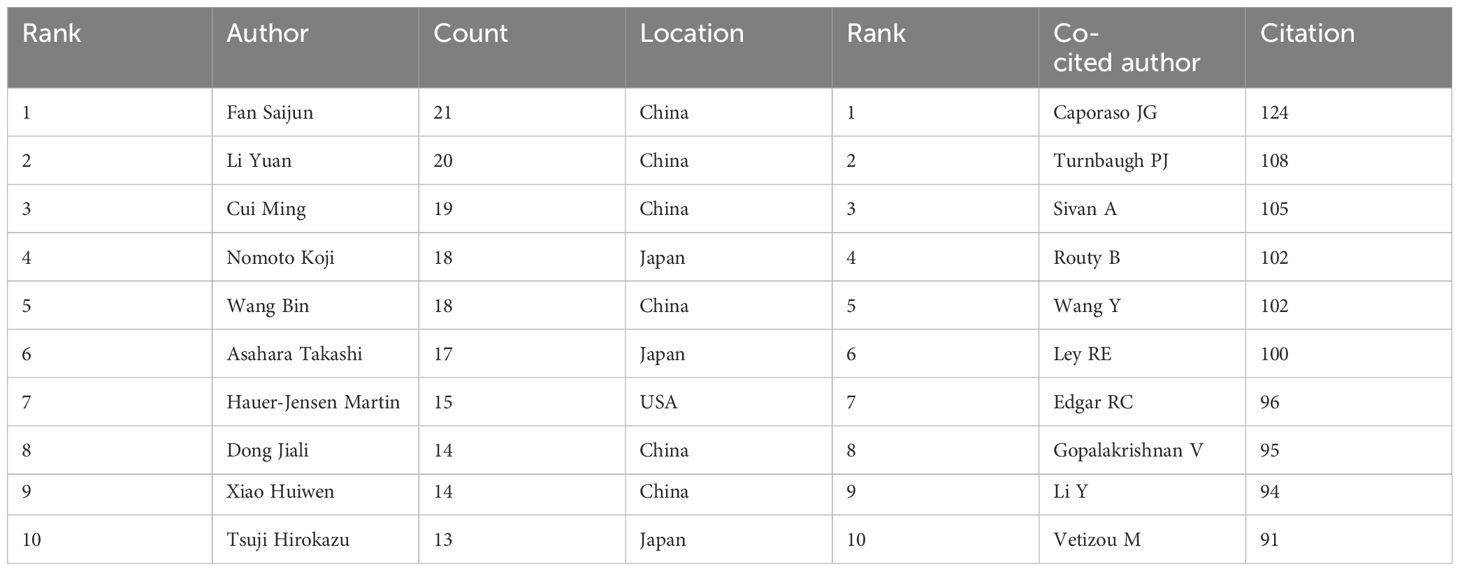
Table 5. Top ten productive authors and co-cited authors in research on gut microbiota and radiotherapy.
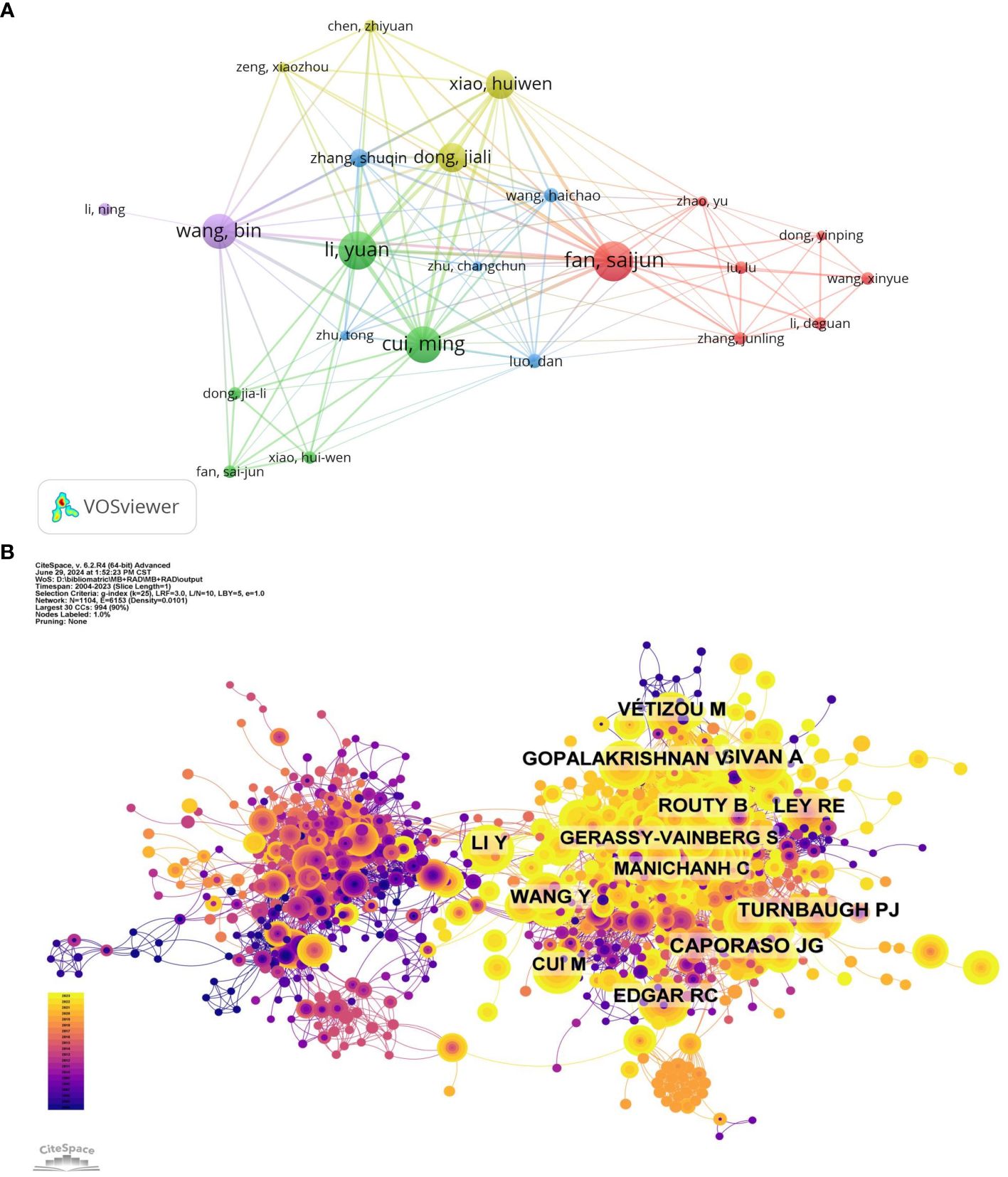
Figure 4. (A) Cooperation network of productive authors obtained with VOS Viewer. The nodes in the map represent authors, and lines between the nodes represent the collaborative relationships. The larger the number of publications, the larger the node area. Colors represent clusters automatically calculated by VOSviewer. (B) Network map of co-cited authors obtained with Cite-Space. The nodes represent co-cited authors. The lines between the nodes represent co-citation relationships. The larger the node area, the larger the number of co-citations. The colors from purple to yellow correspond to the annual time periods of publications from 2004 to 2023.
We examined the time period from 2004 to 2023 and segmented it into one-year intervals for analyzing the dynamic changes in the co-citation network (Figure 5A). This network consists of 1178 nodes (representing authors of literature) and 4382 links (representing citation relationships among these nodes). Table 6 presents the top ten most frequently co-cited references. These investigations highlight the potential role of the gut microbiome in modulating host immune responses, enhancing the effectiveness of cancer treatments, and protecting against RI.
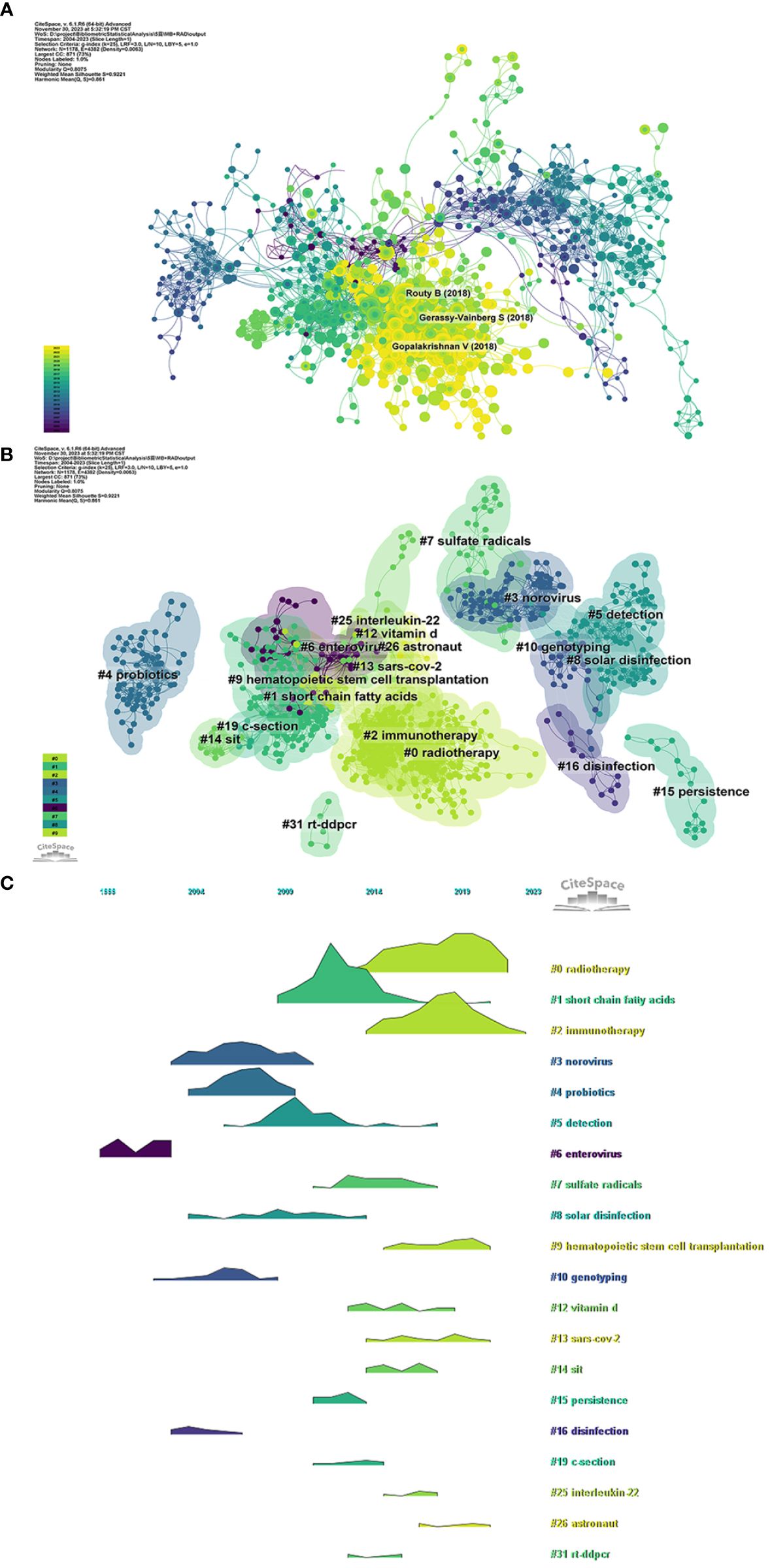
Figure 5. (A) Network map of co-cited references obtained with Cite-Space. The nodes represent co-cited references. The lines between the nodes represent cited relationships. The larger the node area, the larger the number of co-citations. The colors from purple to yellow correspond to the annual time periods of publications from 2004 to 2023. (B) Cluster analysis of co-cited references obtained with Cite-Space. The color of the node corresponds to various clusters. (C) The volcano plot and time-series clustering analysis of co-cited references obtained with Cite-Space.
Co-citation reference clustering and temporal clustering analyses were performed to identify literature clusters with similar topics, methods, or viewpoints within the research field (Figures 5B, C). These findings reveal the changing trends of clusters during specific time periods. Our findings indicate that early research hotspots included enterovirus (cluster 6), norovirus (cluster 3), probiotics (cluster 4), genotyping (cluster 10), and disinfection (cluster 16). Mid-term focal points were short-chain fatty acids (cluster 1), detection (cluster 5), sulfate radicals (cluster 7), solar disinfection (cluster 8), vitamin D (cluster 12), sit (cluster 14), persistence (cluster 15), c-section (cluster 19), interleukin-22 (cluster 25), and rt-ddpcr (cluster 31). Current trending topics and areas of interest in this field are radiotherapy (cluster 0), immunotherapy (cluster 2), hematopoietic stem cell transplantation (cluster 9), SARS-CoV-2 (cluster 13), and astronaut health (cluster 26).
Keyword analysis was performed to determine the hotspots in gut microbiota and radiotherapy. According to the co-occurrence of keywords in VOSviewer, the most popular keywords were expression (160 occurrences), followed by Escherichia coli (151), inflammation (135), and probiotics (101) as shown in Table 7 and Figures 6A, B. After removing non-informative keywords, we constructed a network comprising 169 keywords that appeared at least 27 times, resulting in three distinct clusters. The first group (red) included 98 keywords such as expression, inflammation, probiotics, therapy, chemotherapy, bacterial translocation, metabolism, health, immunity, colorectal cancer, and efficacy. The second group (green) contained 53 keywords, including Escherichia coli, rt-pcr, norovirus, Escherichia coli, temperature, enteric viruses, and murine norovirus. The third group (blue) comprised 18 keywords, including infection, identification, diversity, resistance, prevalence, epidemiology, bacteria, and diagnosis.
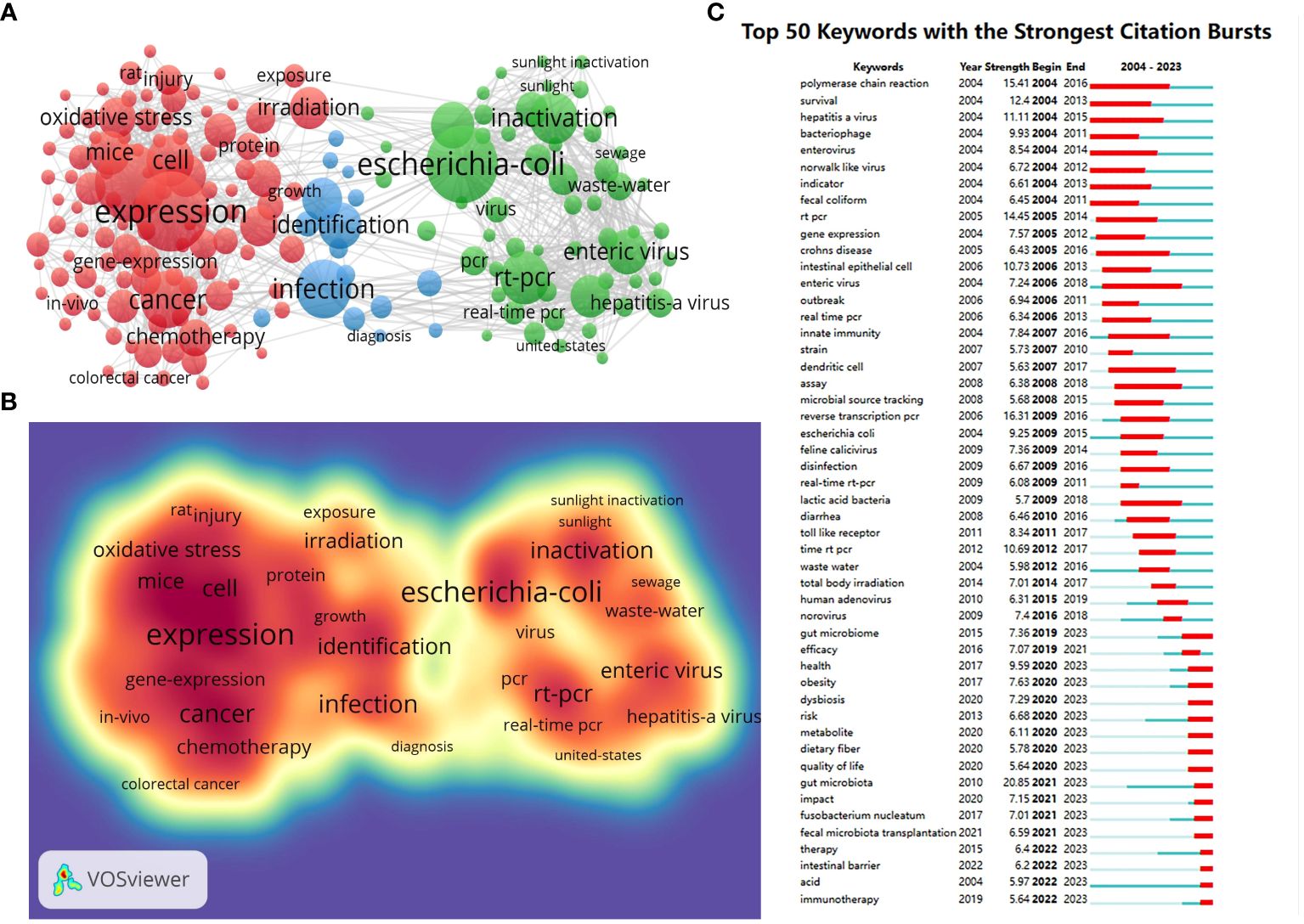
Figure 6. (A) A Network map of high-frequency keywords obtained with VOS Viewer. Colors represent clusters automatically calculated by VOSviewer. Each node represents a different keyword. The size of points means the frequency of keywords. (B) Density visualization map of keywords obtained with obtained with VOS Viewer, with the keywords in red color area appear more frequently. (C) Top 50 keywords with the most robust citation burst obtained with CiteSpace. The blue line indicates the timeline, and the bars in red stands for a burst period including the beginning year, the end year, and the burst duration of the keywords.
Keyword burst patterns were detected to reveal active contents in the field of gut microbiota and radiotherapy over the past two decades. Among 155 keywords with the strongest citation bursts in this field, the top 50 keywords were shown in Figure 6C. We pay special attention to the keywords with a burst period until 2023 among all the burstness keywords because they may represent the current research hotspots in the field and potential directions for future research, such as gut microbiome, health, obesity, dysbiosis, risk, metabolite, dietary fiber, quality of life, gut microbiota, impact, Fusobacterium nucleatum, fecal microbiota transplantation, therapy, intestinal barrier, acid, and immunotherapy.
The relationship between gut microbiota and its corresponding interventions in radiotherapy is becoming a research focus of scholars. This is the first bibliometric analysis to evaluate and visualize research on gut microbiota and radiotherapy. A total of 2821 publications originating from the WoSCC database were analyzed. We offer a detailed analysis of global trends and hotspots in gut microbiota and radiotherapy research over the past two decades, providing crucial insights into the historical development and research frontiers of this field.
The number and trend of publications in a certain field can serve as an indicator of its developmental phases. From the annual number of publications, 2004-2010 belonged to the initial stage of research on gut microbiota and radiotherapy, 2010-2017 was in a steady development stage, and 2017-2023 was in a stage of rapid development. It is noteworthy that the year 2010 saw a pivotal turning point with the establishment of a comprehensive catalog of human gut microbial genes through metagenomic sequencing, thereby inaugurating a new trajectory in the field of gut microbiota research. This uptrend suggests an expanding acknowledgment of the microbiome’s role in modulating radiotherapy effects.
The gradual increase in the annual number of publications also reflects the evolving understanding and emerging curiosity in this field. This interest is further reflected in the notable increase in collaborative efforts and the expansion of research across various global institutions. The research landscape has been shaped by contributions from across the globe, with the USA and China being predominant contributors. Such high levels of research output from these two countries can be partly attributed to the high attention and financial support of the government and the community on the gut microbiota program research. the USA initiated the Human Microbiome Project in 2007, followed by the National Microbiome Initiative in 2016. Similarly, China established the Chinese Academy of Sciences Microbiome Program in 2017. Notably, while China exhibited a substantial volume of publications in the field, it is evident that the average citation counts fell significantly short in comparison to other nations, and there was a notable absence of highly cited papers. This observation suggests the imperative for China to continue enhancing the caliber of its scholarly articles.
Predictions for field development, as extrapolated from the trends in our dataset, indicate a continued interest in investigating how alterations in the gut microbiota due to radiotherapy can lead to various systemic effects, including gastrointestinal, cognitive, and cardiopulmonary dysfunctions, and how to protect against radiation-induced toxicity via gut microbiota, as indicated by the substantial research output from multiple institutions (Cui et al., 2017; Reis Ferreira et al., 2019; Wang et al., 2019; Guo et al., 2020; Ling et al., 2020; Davar et al., 2021; Wang et al., 2023a).
Furthermore, the emergence of certain keywords in our analysis, such as short-chain fatty acids, inflammation, and probiotics, points towards a growing exploration of therapeutic interventions targeting the gut microbiota (Gerassy-Vainberg et al., 2018; Guo et al., 2020; Wang et al., 2021). Such interventions are anticipated to gain more traction in future studies, particularly in mitigating radiation-induced toxicities and enhancing the overall effectiveness of radiotherapy. However, our findings did not indicate a significant relationship between the use of traditional medicine and the main focus of our study. While curcumin has been used to protect gut microbiota, these studies did not emerge as a central theme in the literature we analyzed.
The current hotspots and future trends in this research field, as derived from our bibliometric analysis, suggesting a multi-disciplinary approach that integrates microbiology, oncology, and therapeutics. This approach is pivotal for developing innovative strategies to leverage the gut microbiota in enhancing radiotherapy outcomes and managing radiation-induced complications.
While our study provides comprehensive insights, there are inherent limitations. The reliance on bibliometric data from the WoSCC database may omit relevant studies published in other databases or journals not indexed in WoSCC. Furthermore, the analysis is constrained to articles published in English, potentially overlooking significant contributions in other languages. The interpretation of trends and hotspots is subject to the limitations of the bibliometric method, which primarily focuses on quantitative rather than qualitative assessment of the research.
The intersection of gut microbiota and radiotherapy represents a rapidly evolving research domain, with a clear surge in interest and publications in recent years. This study’s bibliometric analysis has illuminated the growth trends, current hotspots, and potential future directions in this field. The increasing focus on the gut microbiome’s role in radiotherapy underscores its potential as a critical factor in cancer treatment strategies. As the field continues to evolve, it is imperative to overcome current limitations by incorporating diverse research perspectives and methodologies. The insights from this study provide a foundation for future research, encouraging continued exploration and innovation in understanding the complex relationship between gut microbiota and radiotherapy.
The raw data supporting the conclusions of this article will be made available by the authors, without undue reservation.
SW: Conceptualization, Data curation, Formal analysis, Investigation, Methodology, Writing – original draft, Writing – review & editing. ZY: Conceptualization, Data curation, Formal analysis, Investigation, Methodology, Writing – original draft, Writing – review & editing. XG: Conceptualization, Data curation, Investigation, Methodology, Visualization, Writing – original draft, Writing – review & editing. JW: Conceptualization, Data curation, Investigation, Methodology, Visualization, Writing – original draft, Writing – review & editing. YR: Conceptualization, Investigation, Methodology, Visualization, Writing – review & editing. XY: Conceptualization, Funding acquisition, Project administration, Supervision, Writing – review & editing. JL: Conceptualization, Funding acquisition, Project administration, Supervision, Writing – review & editing. WW: Conceptualization, Funding acquisition, Project administration, Supervision, Writing – review & editing.
The author(s) declare financial support was received for the research, authorship, and/or publication of this article. This work was supported by grants from the National Natural Science Foundation of China (No.82103783), Guangdong Provincial Foundation for Basic and Applied Basic Research - Regional Joint Fund (2020A1515110809).
The authors declare that the research was conducted in the absence of any commercial or financial relationships that could be construed as a potential conflict of interest.
All claims expressed in this article are solely those of the authors and do not necessarily represent those of their affiliated organizations, or those of the publisher, the editors and the reviewers. Any product that may be evaluated in this article, or claim that may be made by its manufacturer, is not guaranteed or endorsed by the publisher.
The Supplementary Material for this article can be found online at: https://www.frontiersin.org/articles/10.3389/fcimb.2024.1414196/full#supplementary-material
RI, radiation injury; WoSCC, Web of Science Core Collection; TS, tab search; IF, impact factors.
Bartolomaeus, H., Balogh, A., Yakoub, M., Homann, S., Markó, L., Höges, S., et al. (2019). Short-chain fatty acid propionate protects from hypertensive cardiovascular damage. Circulation 139, 1407–1421. doi: 10.1161/CIRCULATIONAHA.118.036652
Chen, C. (2006). CiteSpace II: Detecting and visualizing emerging trends and transient patterns in scientific literature. J. Assoc. Inf Sci. Technol. 57, 359–377. doi: 10.1002/asi.20317
Chen, C., Leydesdorff, L. (2014). Patterns of connections and movements in dual-map overlays: A new method of publication portfolio analysis. J. Assoc. Inf Sci. Technol. 65, 334–351. doi: 10.1002/asi.22968
Chen, Z., Wang, B., Dong, J., Li, Y., Zhang, S., Zeng, X., et al. (2021). Gut microbiota-derived l-histidine/imidazole propionate axis fights against the radiation-induced cardiopulmonary injury. Int. J. Mol. Sci. 22 (21), 11436. doi: 10.3390/ijms222111436
Crawford, P. A., Gordon, J. I. (2005). Microbial regulation of intestinal radiosensitivity. Proc. Natl. Acad. Sci. U.S.A. 102, 13254–13259. doi: 10.1073/pnas.0504830102
Cui, M., Xiao, H., Li, Y., Zhou, L., Zhao, S., Luo, D., et al. (2017). Fecal microbiota transplantation protects against radiation-induced toxicity. EMBO Mol. Med. 9, 448–461. doi: 10.15252/emmm.201606932
Cui, M., Xiao, H., Luo, D., Zhang, X., Zhao, S., Zheng, Q., et al. (2016). Circadian rhythm shapes the gut microbiota affecting host radiosensitivity. Int. J. Mol. Sci. 17 (11), 1786. doi: 10.3390/ijms17111786
Davar, D., Dzutsev, A. K., McCulloch, J. A., Rodrigues, R. R., Chauvin, J. M., Morrison, R. M., et al. (2021). Fecal microbiota transplant overcomes resistance to anti-PD-1 therapy in melanoma patients. Science 371, 595–602. doi: 10.1126/science.abf3363
Dong, J., Li, Y., Xiao, H., Cui, M., Fan, S. (2021). Commensal microbiota in the digestive tract: a review of its roles in carcinogenesis and radiotherapy. Cancer Biol. Med. 19, 43–55. doi: 10.20892/j.issn.2095-3941.2020.0476
Gerassy-Vainberg, S., Blatt, A., Danin-Poleg, Y., Gershovich, K., Sabo, E., Nevelsky, A., et al. (2018). Radiation induces proinflammatory dysbiosis: Transmission of inflammatory susceptibility by host cytokine induction. Gut 67, 97–107. doi: 10.1136/gutjnl-2017-313789
Guo, H., Chou, W. C., Lai, Y., Liang, K., Tam, J. W., Brickey, W. J., et al. (2020). Multi-omics analyses of radiation survivors identify radioprotective microbes and metabolites. Science 370 (6516), eaay9097. doi: 10.1126/science.aay9097
Lee, Y. S., Kim, T. Y., Kim, Y., Kim, S., Lee, S. H., Seo, S. U., et al. (2021). Microbiota-derived lactate promotes hematopoiesis and erythropoiesis by inducing stem cell factor production from leptin receptor+ niche cells. Exp. Mol. Med. 53, 1319–1331. doi: 10.1038/s12276-021-00667-y
Li, Z., Ke, X., Zuo, D., Wang, Z., Fang, F., Li, B. (2022). New insights into the relationship between gut microbiota and radiotherapy for cancer. nutrients 15 (1), 48. doi: 10.3390/nu15010048
Ling, F., Steinel, N., Weber, J., Ma, L., Smith, C., Correa, D., et al. (2020). The gut microbiota response to helminth infection depends on host sex and genotype. Isme J. 14, 1141–1153. doi: 10.1038/s41396-020-0589-3
Liu, G., Yu, Q., Tan, B., Ke, X., Zhang, C., Li, H., et al. (2022). Gut dysbiosis impairs hippocampal plasticity and behaviors by remodeling serum metabolome. Gut Microbes 14, 2104089. doi: 10.1080/19490976.2022.2104089
Liu, X., Zhou, Y., Wang, S., Guan, H., Hu, S., Huang, R., et al. (2019). Impact of low-dose ionizing radiation on the composition of the gut microbiota of mice. Toxicol. Sci. 171, 258–268. doi: 10.1093/toxsci/kfz144
Lucas, S., Omata, Y., Hofmann, J., Böttcher, M., Iljazovic, A., Sarter, K., et al. (2018). Short-chain fatty acids regulate systemic bone mass and protect from pathological bone loss. Nat. Commun. 9, 55. doi: 10.1038/s41467-017-02490-4
Merigó, J. M., Yang, J.-B. (2017). A bibliometric analysis of operations research and management science. Omega 73, 37–48. doi: 10.1016/j.omega.2016.12.004
Miousse, I. R., Ewing, L. E., Skinner, C. M., Pathak, R., Garg, S., Kutanzi, K. R., et al. (2020). Methionine dietary supplementation potentiates ionizing radiation-induced gastrointestinal syndrome. Am. J. Physiol. Gastrointest Liver Physiol. 318, G439–Gg50. doi: 10.1152/ajpgi.00351.2019
Nenclares, P., Bhide, S. A., Sandoval-Insausti, H., Pialat, P., Gunn, L., Melcher, A., et al. (2020). Impact of antibiotic use during curative treatment of locally advanced head and neck cancers with chemotherapy and radiotherapy. Eur. J. Cancer 131, 9–15. doi: 10.1016/j.ejca.2020.02.047
Nishiyama, Y., Morita, A., Tatsuta, S., Kanamaru, M., Sakaue, M., Ueda, K., et al. (2021). Isorhamnetin promotes 53BP1 recruitment through the enhancement of ATM phosphorylation and protects mice from radiation gastrointestinal syndrome. Genes (Basel) 12 (10), 1514. doi: 10.3390/genes12101514
Noda, K., Lim, Y., Sengoku, S., Kodama, K. (2023). Global biomarker trends in Alzheimer’s research: A bibliometric analysis. Drug Discovery Today 28, 103677. doi: 10.1016/j.drudis.2023.103677
Paulos, C. M., Wrzesinski, C., Kaiser, A., Hinrichs, C. S., Chieppa, M., Cassard, L., et al. (2007). Microbial translocation augments the function of adoptively transferred self/tumor-specific CD8+ T cells via TLR4 signaling. J. Clin. Invest. 117, 2197–2204. doi: 10.1172/JCI32205
Ramadan, M., Hetta, H. F., Saleh, M. M., Ali, M. E., Ahmed, A. A., Salah, M. (2021). Alterations in skin microbiome mediated by radiotherapy and their potential roles in the prognosis of radiotherapy-induced dermatitis: A pilot study. Sci. Rep. 11, 5179. doi: 10.1038/s41598-021-84529-7
Reis Ferreira, M., Andreyev, H. J. N., Mohammed, K., Truelove, L., Gowan, S. M., Li, J., et al. (2019). Microbiota- and radiotherapy-induced gastrointestinal side-effects (MARS) study: A large pilot study of the microbiome in acute and late-radiation enteropathy. Clin. Cancer Res. 25, 6487–6500. doi: 10.1158/1078-0432.CCR-19-0960
Russo, M., Guida, F., Paparo, L., Trinchese, G., Aitoro, R., Avagliano, C., et al. (2019). The novel butyrate derivative phenylalanine-butyramide protects from doxorubicin-induced cardiotoxicity. Eur. J. Heart Fail 21, 519–528. doi: 10.1002/ejhf.1439
Schuijt, T. J., Lankelma, J. M., Scicluna, B. P., de Sousa e Melo, F., Roelofs, J. J., de Boer, J. D., et al. (2016). The gut microbiota plays a protective role in the host defense against pneumococcal pneumonia. Gut 65, 575–583. doi: 10.1136/gutjnl-2015-309728
Song, C., Duan, F., Ju, T., Qin, Y., Zeng, D., Shan, S., et al. (2022). Eleutheroside E supplementation prevents radiation-induced cognitive impairment and activates PKA signaling via gut microbiota. Commun. Biol. 5, 680. doi: 10.1038/s42003-022-03602-7
Su, Z., Tian, C., Wang, G., Guo, J., Yang, X. (2023). Study of the effect of intestinal microbes on obesity: A bibliometric analysis. Nutrients 15 (14), 3255. doi: 10.3390/nu15143255
Thelwall, M. (2008). Bibliometrics to webometrics. J. Inf. Sci. 34, 605–621. doi: 10.1177/0165551507087238
Trompette, A., Pernot, J., Perdijk, O., Alqahtani, R. A. A., Domingo, J. S., Camacho-Muñoz, D., et al. (2022). Gut-derived short-chain fatty acids modulate skin barrier integrity by promoting keratinocyte metabolism and differentiation. Mucosal Immunol. 15, 908–926. doi: 10.1038/s41385-022-00524-9
Van Eck, N., Waltman, L. (2010). Software survey: VOSviewer, a computer program for bibliometric mapping. Scientometrics 84, 523–538. doi: 10.1007/s11192-009-0146-3
Van Eck, N. J., Waltman, L. (2017). Citation-based clustering of publications using CitNetExplorer and VOSviewer. Scientometrics 111, 1053–1070. doi: 10.1007/s11192-017-2300-7
Wang, W., Cui, B., Nie, Y., Sun, L., Zhang, F. (2023a). Radiation injury and gut microbiota-based treatment. Protein Cell. 15 (2), 83–97. doi: 10.1093/procel/pwad044
Wang, W., Li, T., Wang, Z., Yin, Y., Zhang, S., Wang, C., et al. (2023b). Bibliometric analysis of research on neurodegenerative diseases and single-cell RNA sequencing: Opportunities and challenges. iScience 26 (10), 107833. doi: 10.1016/j.isci.2023.107833
Wang, W., Lu, G., Wu, X., Wen, Q., Zhang, F. (2023c). Colonic transendoscopic enteral tubing is a new pathway to microbial therapy, colonic drainage, and host-microbiota interaction research. J. Clin. Med. 12 (3), 780. doi: 10.3390/jcm12030780
Wang, Z., Chen, W. H., Li, S. X., He, Z. M., Zhu, W. L., Ji, Y. B., et al. (2021). Gut microbiota modulates the inflammatory response and cognitive impairment induced by sleep deprivation. Mol. Psychiatry 26, 6277–6292. doi: 10.1038/s41380-021-01113-1
Wang, Z., Wang, Q., Wang, X., Zhu, L., Chen, J., Zhang, B., et al. (2019). Gut microbial dysbiosis is associated with development and progression of radiation enteritis during pelvic radiotherapy. J. Cell Mol. Med. 23, 3747–3756. doi: 10.1111/jcmm.14289
Yang, M., Liu, Q., Dai, M., Peng, R., Li, X., Zuo, W., et al. (2022). FOXQ1-mediated SIRT1 upregulation enhances stemness and radio-resistance of colorectal cancer cells and restores intestinal microbiota function by promoting β-catenin nuclear translocation. J. Exp. Clin. Cancer Res. 41, 70. doi: 10.1186/s13046-021-02239-4
Yang, J. B., Zhu, D. Q., Shao, M., Li, A. W., Liu, Z. R., Gao, R. J., et al. (2019). [Effects of Shengmai Jianghuang San on intestinal flora in nude mice with radio resistant cells of nasopharyngeal carcinoma]. Zhongguo Zhong Yao Za Zhi 44, 553–558. doi: 10.19540/j.cnki.cjcmm.20181203.001
Keywords: gut microbiota, cancer, radiotherapy, radiosensitivity, gut-organ axis
Citation: Wang S, Yuan Z, Gao X, Wu J, Ren Y, Yu X, Li J and Wei W (2024) Global research trends on the links between gut microbiota and radiotherapy: a bibliometric analysis (2004-2023). Front. Cell. Infect. Microbiol. 14:1414196. doi: 10.3389/fcimb.2024.1414196
Received: 08 April 2024; Accepted: 12 July 2024;
Published: 04 September 2024.
Edited by:
Linglong Peng, Chongqing Medical University, ChinaReviewed by:
Veeranoot Nissapatorn, Walailak University, ThailandCopyright © 2024 Wang, Yuan, Gao, Wu, Ren, Yu, Li and Wei. This is an open-access article distributed under the terms of the Creative Commons Attribution License (CC BY). The use, distribution or reproduction in other forums is permitted, provided the original author(s) and the copyright owner(s) are credited and that the original publication in this journal is cited, in accordance with accepted academic practice. No use, distribution or reproduction is permitted which does not comply with these terms.
*Correspondence: Jianxiong Li, MzAxbGp4QHNpbmEuY29t; Wei Wei, ZHJfd2Vpd2VpNTI4QDE2My5jb20=
†These authors have contributed equally to this work
Disclaimer: All claims expressed in this article are solely those of the authors and do not necessarily represent those of their affiliated organizations, or those of the publisher, the editors and the reviewers. Any product that may be evaluated in this article or claim that may be made by its manufacturer is not guaranteed or endorsed by the publisher.
Research integrity at Frontiers

Learn more about the work of our research integrity team to safeguard the quality of each article we publish.